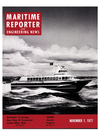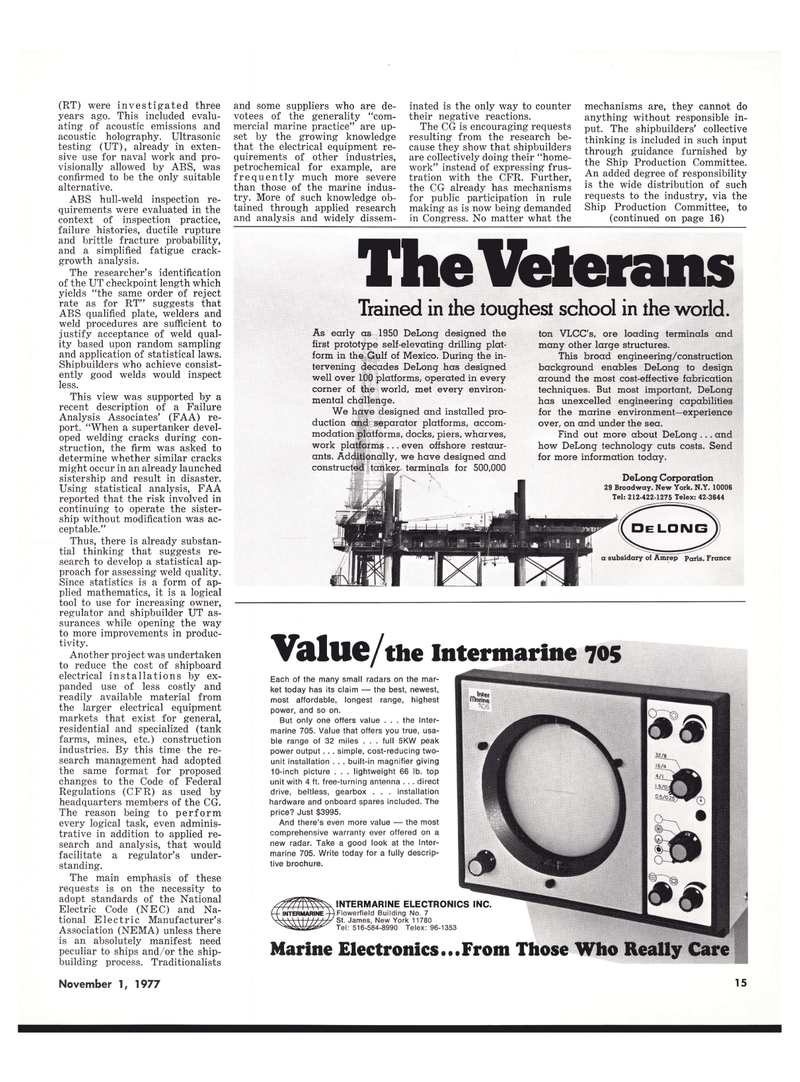
Page 15: of Maritime Reporter Magazine (November 1977)
Read this page in Pdf, Flash or Html5 edition of November 1977 Maritime Reporter Magazine
(RT) were investigated three years ago. This included evalu- ating of acoustic emissions and acoustic holography. Ultrasonic testing (UT), already in exten- sive use for naval work and pro- visionally allowed by ABS, was confirmed to be the only suitable alternative.
ABS hull-weld inspection re- quirements were evaluated in the context of inspection practice, failure histories, ductile rupture and brittle fracture probability, and a simplified fatigue crack- growth analysis.
The researcher's identification of the UT checkpoint length which yields "the same order of reject rate as for RT" suggests that
ABS qualified plate, welders and weld procedures are sufficient to justify acceptance of weld qual- ity based upon random sampling and application of statistical laws.
Shipbuilders who achieve consist- ently good welds would inspect less.
This view was supported by a recent description of a Failure
Analysis Associates' (FAA) re- port. "When a supertanker devel- oped welding cracks during con- struction, the firm was asked to determine whether similar cracks might occur in an already launched sistership and result in disaster.
Using statistical analysis, FAA reported that the risk involved in continuing to operate the sister- ship without modification was ac- ceptable."
Thus, there is already substan- tial thinking that suggests re- search to develop a statistical ap- proach for assessing weld quality.
Since statistics is a form of ap- plied mathematics, it is a logical tool to use for increasing owner, regulator and shipbuilder UT as- surances while opening the way to more improvements in produc- tivity.
Another project was undertaken to reduce the cost of shipboard electrical installations by ex- panded use of less costly and readily available material from the larger electrical equipment markets that exist for general, residential and specialized (tank farms, mines, etc.) construction industries. By this time the re- search management had adopted the same format for proposed changes to the Code of Federal
Regulations (CFR) as used by headquarters members of the CG.
The reason being to perform every logical task, even adminis- trative in addition to applied re- search and analysis, that would facilitate a regulator's under- standing.
The main emphasis of these requests is on the necessity to adopt standards of the National
Electric Code (NEC) and Na- tional Electric Manufacturer's
Association (NEMA) unless there is an absolutely manifest need peculiar to ships and/or the ship- building process. Traditionalists and some suppliers who are de- votees of the generality "com- mercial marine practice" are up- set by the growing knowledge that the electrical equipment re- quirements of other industries, petrochemical for example, are frequently much more severe than those of the marine indus- try. More of such knowledge ob- tained through applied research and analysis and widely dissem- inated is the only way to counter their negative reactions.
The CG is encouraging requests resulting from the research be- cause they show that shipbuilders are collectively doing their "home- work" instead of expressing frus- tration with the CFR. Further, the CG already has mechanisms for public participation in rule making as is now being demanded in Congress. No matter what the mechanisms are, they cannot do anything without responsible in- put. The shipbuilders' collective thinking is included in such input through guidance furnished by the Ship Production Committee.
An added degree of responsibility is the wide distribution of such requests to the industry, via the
Ship Production Committee, to (continued on page 16)
The Veterans
Trained in the toughest school in the world.
As early as 1950 DeLong designed the first prototype self-elevating drilling plat- form in the Gulf of Mexico. During the in- tervening decades DeLong has designed well over 100 platforms, operated in every corner of the world, met every environ- mental challenge.
We have designed and installed pro- duction and separator platforms, accom- modation platforms, docks, piers, wharves, work platforms .. . even offshore restaur- ants. Additionally, we have designed and constructed tanker terminals for 500,000 ton VLCC's, ore loading terminals and many other large structures.
This broad engineering/construction background enables DeLong to design around the most cost-effective fabrication technigues. But most important, DeLong has unexcelled engineering capabilities for the marine environment—experience over, on and under the sea.
Find out more about DeLong . .. and how DeLong technology cuts costs. Send for more information today.
DeLong Corporation 29 Broadway. New York, N.Y. 10006
Tel: 212-422-1275 Telex: 42-3644 a subsidary of Amrep Paris, France
Value/the Intermarine 70S
Each of the many small radars on the mar- ket today has its claim — the best, newest, most affordable, longest range, highest power, and so on.
But only one offers value . . . the Inter- marine 705. Value that offers you true, usa- ble range of 32 miles . . . full 5KW peak power output. . . simple, cost-reducing two- unit installation . . . built-in magnifier giving 10-inch picture . . . lightweight 66 lb. top unit with 4 ft. free-turning antenna . . . direct drive, beltless, gearbox . . . installation hardware and onboard spares included. The price? Just $3995.
And there's even more value — the most comprehensive warranty ever offered on a new radar. Take a good look at the Inter- marine 705. Write today for a fully descrip- tive brochure. ^^INTERMARINE ELECTRONICS INC. - INTERMARINE -+) Flowerfield Building No. 7 ^rHm/ St. James, New York 11780 Tel: 516-584-8990 Telex: 96-1353
Marine Electronics...From Those Who Really Care
November 1, 1977 15

 14
14

 16
16
